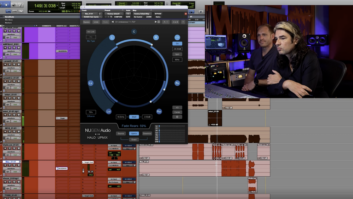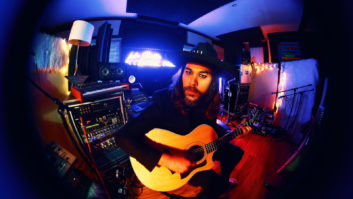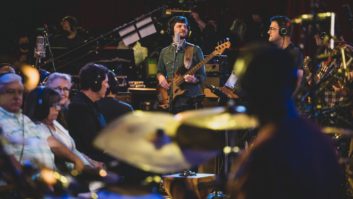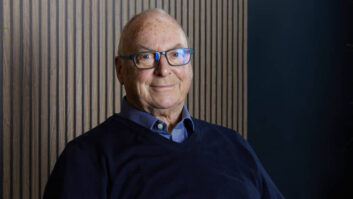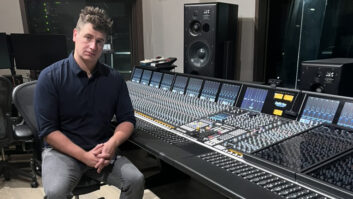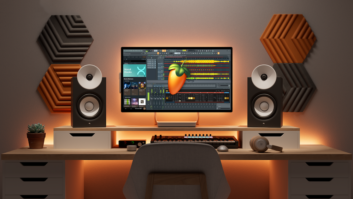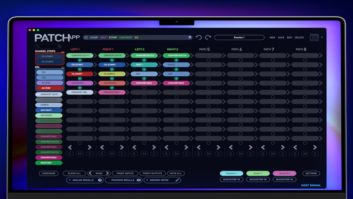Who would have ever thought that a pair of Technics turntables, a microphone and a mixer could change pop music forever? With the drop of a needle and the flick of a fader, more than 20 years ago hip hop was born. As a truly American phenomenon, what could be a more fitting epicenter for hip hop music and culture than New York City? Detroit may lay claim to techno, London to trance and Bristol to trip hop. But New York City, to the chagrin of many on the West Coast, remains the center of the rap world.
Today, New York’s up-and-coming urban producers are second-generation hip hop mavens — people in their 20s and early 30s who are much more savvy about the business side of music, while keeping their fingers squarely on the pulse of urban culture. These new producers find their way to the scene from various places, but mostly via a few well-marked routes, usually either from the DJ demimonde or as more “traditional” musicians. They’re mostly not tech-heads — their world still often revolves around the decade-old MPC-1000s, though many of them are well-versed in Pro Tools and Logic. They come to the party as some combination of composer, producer, player and/or entrepreneur, and collaborate with each other through a seemingly endless network of musicians and producers.
The “hub of hip hop” characterization of New York definitely belongs to James Poyser, a native of Philadelphia who still lives in that city where Gamble & Huff mentored him, but who spends so much of his working time in Manhattan studios that the concierges at the SoHo Grand know him by name. Poyser came up as a musician, playing drums, bass and then keyboards in church and in local bands. He is credited as keyboard player on a number of major albums, but like many of his contemporaries, he sees playing as more of a tool for production than an end in and of itself.
“In the past few years, hip hop has been a programmer and a guy with some equipment, and they come up with beats and tracks and that turns into a song,” he says. “You’re already a producer at that point. You got the track, just no one to produce yet. But what you do when you do it like that is give an artist one-stop shopping. There’s been some times when I wrote the song and I didn’t produce the track, and sometimes I’ve produced a track I didn’t write. But that’s not the norm.”
Poyser has brought “one-stop shopping” to records for Erykah Badu, D’Angelo, Jill Scott, The Roots and Lauryn Hill, collaborating on writing and producing tracks with them. He works closely with his partners in the Axis Music Group, Chauncy Childs and Vikter Duplayix; all are members of the Soulquarians collective of producers and programmers. Poyser is also what he calls an honorary member of The Root collective, which led to his production credits on Erykah Badu’s breakthrough Baduizm LP in 1997. Royalty points and other compensation are split among the members based on their input into each record, and Poyser says this ad hoc financial system has worked flawlessly so far. (The rest of the world is not always so cooperative; Poyser and several other producers, songwriters and musicians remain entangled in a much-publicized legal imbroglio with artist Lauryn Hill regarding crediting and royalties stemming from her 1998 multi-Platinum solo debut The Miseducation of Lauryn Hill.)
You don’t have to know how to do everything. You have to know how to make beats and want to be a producer.
— IRV GOTTI
Unlike many other hip hop producers, Poyser prefers to play parts live, or at least sample his own sounds from vintage R&B records, creating a kit he plays through an MPC-2000 drum machine and sequences on Logic Audio software. He also uses a lot of vintage analog equipment, both signal processing and instruments, including a Fender Rhodes 88 suitcase electric piano, a Wurlitzer electric piano, a Sequential Circuits Prophet 5 synth, a Mini Moog and a Roland Juno 106 synthesizer. “It’s almost like a rebellion against the techno sounds that you get a lot of in rap and hip hop these days,” he explains. “It’s the reason I also like to use analog tape. There’s a certain sound to digital things that I don’t like.”
Like Poyser, producer Bink Dawg started out as a musician and also played drums in church, in his hometown of Norfolk, Va. His breakthrough came in that same area, when producer/artist Teddy Riley, who has a six-studio facility in Virginia Beach, heard a demo that Dawg was working on for a friend. “He asked me to play some more and I played him the song ‘Don’t Leave,’ and he said we’re going into the studio tonight to cut that, and it became a hit,” he recalls.
With a few good credits under his belt, Dawg moved to New York and has since produced and programmed for numerous artists, including Missy Elliot, the Lost Boyz, Queens’ Most Wanted, Mr. Sexxx, DJ Ron G and Easy Mo Bee. He has his own studio in Queens, where he works an MP-3000 sequencer to a Pro Tools rig through a pair of Yamaha 02R digital mixers. However, he also likes analog for drums, often cutting to half-inch, 8-track analog for that.
Digital sampling remains a core methodology for rap and hip hop, and can be as much a calling card as a CD component. “When I was starting out, I always carried my Walkman with my beats on it, and I would give them out to A&R guys,” says Dawg. But sampling and litigation have been almost inseparable since the 1990s, and keeping current with due diligence has created a snowstorm of paper for rap sessions as producers log the myriad sources of samples for credit and royalty purposes. “If you don’t have the paperwork in order, the label won’t put the record out,” says Dawg, noting that some copyright holders can claim as much as three-quarters of a song’s rights if the record is released with copyright violations. “That happened to me a few times when I was younger. What happens is, people hear things you did years ago and want to use them, and you didn’t keep track of where the samples came from, or you can’t find the records or the name of the publisher. And you have to make sure that any samples the artists want to use have been cleared first, too. And you do it before the session, so you don’t waste it.”
There’s another morality component to sampling, less enforceable legally but widely adhered to by producers. “You want to use a sample in good taste,” says Dawg. “You want the song that it’s going to be used on to have the same kind of message as the one you sampled it from. Especially if there’s profanity on the record. As long as you respect that, you usually never get refused permission.”
The majority of rap producers in New York are African-American, but most of the engineers who record the music are Caucasian. No one argues this fact, nor do they spend much time pondering its significance, if any. What urban producers are looking for in an engineer, regardless of race, is the ability to translate verbal descriptives into actual sounds and moves. “[Engineering] in rap is different than it is in pop music,” Dawg states. “I think the moves are more intricate, you play with the beats more. You have to have a real feel for the beats to make the punches. You can’t catch the punch if you can’t catch the beat.”
I definitely have to act more in the capacity of defining what sounds good and what doesn’t. The up-and-coming producers may not know what you need to make a competitive record.
— MAYHEM
Adds Poyser, “Your job as a producer is to know what you want to hear and to be able to communicate it. In terms of engineering, I prefer to think about the music more than the technology. There are things I’ve learned about that, but getting your hands too deep in that takes away from the creativity, I think. It’s hard enough to be a player, producer and writer all at the same time.”
Irv Gotti came up as a DJ, working first in his neighborhood of Hollis, Queens, inspired by, as he puts it, “sitting there watching Run-DMC rule the world.” He is also less interested in the equipment than the music itself. Yet he has spent a long time in studios in New York, starting out on a Fostex 8-track deck and a “bullshit” console. It was the collaborative nature of New York rap that got Gotti — a nom de musique conferred on him by rapper Jay-Z to commemorate the founding of Gotti’s production company, Murder Inc. — into the loop, so to speak. “My first artist was Mike Geronimo, and I made that record and produced it and pressed it myself, and also did the video. My friends helped me out on everything,” he says. “You don’t have to know how to do everything. You have to know how to make beats and want to be a producer. But you meet people who can play and do engineering, and they took my production to another level.”
That first record turned out to be Gotti’s break when leading New York-area urban radio station Hot 97 put it into heavy rotation, after which it was picked up by Blunt/TVT Records, which also gave Gotti a production deal. He now also has his own studio, The Crackhouse, in Manhattan, and an office at Island/Def Jam Records, which has a joint-venture with Murder Inc. Gotti’s discography includes tracks for Foxy Brown, DMX, Ja Rule and Wu Tang Clan’s Ol’ Dirty Bastard.
Having a personal studio has become nearly essential in rap/hip hop, both for artistic and economic reasons. As Gotti puts it, “I did it ’cause I didn’t want to give all my money to [the commercial studios].” Bink Dawg agrees, adding, “We realized that we could spend one-tenth and send the P.O. to the label and the money back in our pocket. It’s a waste of money sitting around doing beats in big studios.” Says Gotti, “Those studios also get booked and you can’t get in. Besides, when I saw that there was a $300,000 [recording budget], I said to myself, ‘I gotta do some recording.’”
Being a producer is just a start — what you really want is to be known as the guy who can break an artist.
— BINK DAWG
Still, all those we interviewed also agree that top-tier studios are an important component in urban records, mostly for mixing on large automated consoles. And, says Dawg, the personal studio isn’t for everyone. “There are a lot of people scared to take that step,” he says. “It can be a big investment. Also, sometimes you need to have three or four rooms going at once, and the big studios can do that.”
Major commercial studios also can act as a reference for audio quality, though defining that in hip hop and rap is tricky, because “grime” on the track is often a by-product of the creative process itself, where distortion and other artifacts can actually lend credibility to the finished song. “You want a rap record that sounds as clear as an R&B record but is still grimey,” says Dawg. “A record shouldn’t have to suffer to sound street. It can sound good and still come across as hard-core.”
Nonetheless, major record labels in New York — which are not at all displeased to see recording moving into the producers’ studios — have found themselves acting in the role of quality arbiters, telling producers where the threshold needs to be. Mayhem, director of A&R at Elektra Records in Manhattan, says, “I definitely have to act more in the capacity of defining what sounds good and what doesn’t. The up-and-coming producers may not know what you need to make a competitive record, or what you need on a track to make it work for radio or for the clubs, for the level of quality you need to have on a major label release. I’ve become the litmus test for the [track].”
Mayhem, who has final approval for certain recording budgets at Elektra, agrees with the producers that money for overdubs is better spent at personal studios, and technology such as Pro Tools allows virtually every aspect of recording, up to and including mixes, to be done faster and less expensively. He’s also very up-front about the fact that this allows the label to actually cut budgets on individual recording projects, and further allows Elektra to literally double the number of rap records it funds and releases. “If I can make twice as many records, I have twice as many chances of having a record hit big,” Mayhem reasons. As for the big studios, he believes that they will always be in demand by top artists, including rappers. “A guy like LL Cool J, he wants to be in a place like the Hit Factory,” he says.
Still, producers are aware that technical aspects of record-making need to be addressed at all stages of production. Bink Dawg, for instance, points out that he tries to make his samples as tight and as high-res as possible. “You don’t fix a bad sample in the mix,” he states. “And a good sample makes the engineer’s job a lot easier.”
James Poyser knows that there’s a world of difference between a Neumann U87 and a Shure 57. Still, he says both have their place on vocals. “I’ve cut vocals on a 57, though I try not to,” he says. “It all depends on the voice and the vibe. When guys start worrying about perfection, it takes away from the vibe. I’ve tolerated distortion on vocal tracks if it’s part of the vibe. You want a clean signal, but sometimes noise is a great thing. On Erykah’s [Badu] record, there were times when she just grabbed the 57 and sang into it, and that was the vocal. You can hear her talking under some of the tracks; you can hear that kind of stuff on D’Angelo’s records, too. There are tracks where you can hear [programmer/drummer] Amir Thompson’s cell phone going off. It’s organic if it happens on the session. It’s like going back to mom’s house for dinner: It’s not cooked up by a great French chef, but there’s something special about home cookin’, even when it’s not perfect.”
All of this underscores the fact that this particular universe is less about making technically great records than it is about climbing a much larger ladder. Entrepreneurship interlaces every action in hip hop, in or out of the studio. Bink Dawg puts it most plainly when he says his ambition as a producer is to “conquer the game like Jermaine [Dupree] and Puffy did. Being a producer is just a start — what you really want is to be known as the guy who can break an artist. All the while you’re making records, you’re also building your production company and building relationships with the record labels. By producing records, I’m getting seasoned for the game. You start out as a guy doing beats and you want to end up president of a record label, or whatever. Producing is something you do along the way.”
And New York is the ultimate test track for urban’s next generation of producers. While they may be coming of age in a very different landscape than rap’s earlier days, they are acutely conscious of the heritage they’ve become a part of, and of hip hop’s ability to embrace change. “There are a lot of different kinds of music that rap embraces,” says Poyser. “And that’s exactly why it’s endured so long.”
Dan Daley is Mix’s East Coast editor.

